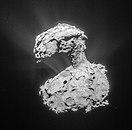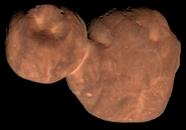| |||
Contact binaries of varying probability among the small Solar System bodies:
| |||
A contact binary is a small Solar System body such as a minor planet or a comet that is composed of two bodies that have gravitated toward each other until they touch, resulting in a bilobated, peanut-like overall shape. Contact binaries are often rubble piles but distinct from real binary systems such as binary asteroids. The term is also used for stellar contact binaries.
An example of a what is thought to be a contact binary is the Kuiper belt object 486958 Arrokoth, which was imaged by the New Horizons spacecraft during its flyby in January 2019.[1]
Description
Comet Churyumov–Gerasimenko and Comet Tuttle are most likely contact binaries,[2][3] while asteroids suspected of being contact binaries include the unusually elongated 624 Hektor and the bilobated 216 Kleopatra and 4769 Castalia. 25143 Itokawa, which was photographed by the Hayabusa probe, also appears to be a contact binary which has resulted in an elongated, bent body. Asteroid 4179 Toutatis with its elongated shape, as photographed by Chang'e-2, is a contact binary candidate as well.[4] Among the distant minor planets, the icy Kuiper belt object Arrokoth was confirmed to be a contact binary when the New Horizons spacecraft flew past in 2019.[1]
Candidates
The table contains near-Earth objects observed by radar, considered to be contact binaries (candidate objects with a darker background).[5] LCDB = Lightcurve Database.
| Object | Mean-diameter or Dimension (km) | Rotation period (hours) | LCDB | Refs |
|---|---|---|---|---|
| 2063 Bacchus | 2.6×1.1×1.1 | 14.9 | LCDB | catalog MPC JPL |
| 4450 Pan | 1.0 | 60 | LCDB | catalog MPC JPL |
| 4486 Mithra | 1.6 | 67.5 | LCDB | catalog MPC JPL |
| 4769 Castalia | 0.6 | 4 | LCDB | catalog MPC JPL |
| 11066 Sigurd | 3.0 | 8.5 | LCDB | catalog MPC JPL |
| (179806) 2002 TD66 | 0.3 | 9.5 | LCDB | catalog MPC JPL |
| 2005 TF49 | — | — | LCDB | (candidate) MPC · JPL |
| 2007 TU24 | 0.3 | 36 | LCDB | MPC · JPL |
| 8P/Tuttle | 4.5 | — | LCDB | MPC · JPL |
| 2013 US3 | 0.163 | 450 | LCDB | (candidate) MPC · JPL |
| 3752 Camillo | 2.33 | 37.846 | LCDB | catalog MPC JPL |
| 1981 Midas | 1.95 | 5.220 | LCDB | catalog MPC JPL |
| (496817) 1989 VB | 0.310 | 16 | LCDB | catalog MPC JPL |
| 2014 JO25 | 0.818 | 4.531 | LCDB | MPC · JPL |
| 2014 HQ124 | 0.4 | 16+ | LCDB | MPC · JPL |
| 2015 JD1 | — | — | LCDB | MPC · JPL |
| (413260) 2003 TL4 | 0.392 | 27.2 | LCDB | (candidate) catalog MPC JPL |
| (462959) 2011 DU | 0.188 | 10.290 | LCDB | (candidate) catalog MPC JPL |
See also
References
- ^ a b "Ultima Thule is first contact binary to be explored by a spacecraft". UPI. Retrieved 21 September 2019.
- ^ Quick Rosetta update: Churyumov-Gerasimenko is a contact binary!
- ^ Success! A final flawless burn. Rosetta now in tandem with its comet
- ^ The formation mechanism of 4179 Toutatis' elongated bi-lobed structure in a close Earth encounter scenario
- ^ Dr. Lance A. M. Benner (18 November 2013). "Binary and Ternary near-Earth Asteroids detected by radar". NASA/JPL Asteroid Radar Research. Retrieved 1 March 2014.


_Itokawa.jpg)